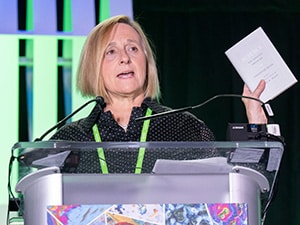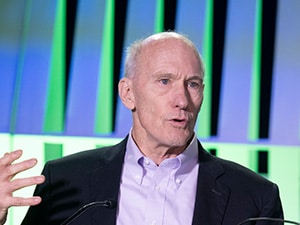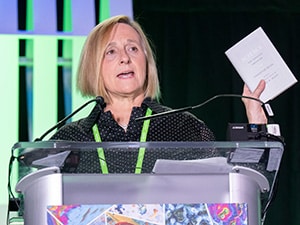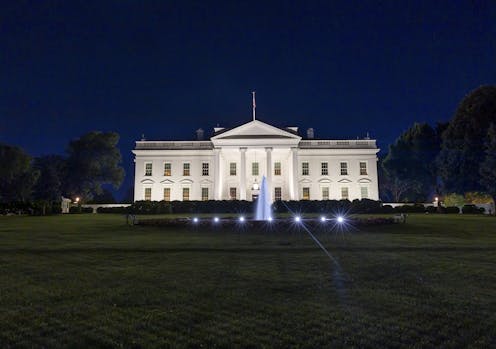Many of the most influential minds in cancer immunotherapy have come together at AACR IO, held from February 23-26 in Los Angeles. On the third day, attendees heard compelling keynote addresses by CAR T-cell pioneers Crystal Mackall, MD, FAACR, and Carl H. June, MD, FAACR. Their talks explored how far the field of cell therapy has come, but more importantly, how we might unleash the incredible potential of these technologies that recent discoveries hint at.
Protecting Public Investment in Science
Before the speakers shared their visions of the new frontiers that might lie ahead for CAR T cells, the session began with a sobering reflection of the U.S. government’s proposed cuts to the National Institutes of Health (NIH) and National Science Foundation (NSF) and a heartfelt call to action from Mackall, the Ernest and Amelia Gallo Family Professor and professor of pediatrics and medicine at Stanford University, the founding director of the Stanford Center for Cancer Cell Therapy, associate director of the Stanford Cancer Institute, leader of the Cancer Immunotherapy Program, and director of the Parker Institute for Cancer Immunotherapy at Stanford. Mackall stressed that scientists must use their voices to make clear the importance of public investment in science and educate people on the numerous benefits this funding has provided in terms of public health, among other areas.

“I am going to talk about CAR T-cell therapies for solid cancers, but before I do I need to step back and discuss some of the situations we find ourselves in today,” began Mackall.
“We’ve now begun to see real reductions in mortality rate [from] cancer in the last decade,” she said, crediting the massive investments in basic research that started after World War II that expanded oncology research, specifically with the passage of the National Cancer Act and creation of the National Cancer Institute in 1971.
“We have believed that if we’re making discoveries and we’re doing good science, we’re doing our job,” Mackall confessed.
Instead, she emphasized, scientists must also take a more active role in educating the public about their work and its significance, stressing that public awareness and advocacy for science are more critical than ever.
“We all need to come together and do everything we can to stop this movement from gaining additional traction,” Mackall concluded, referring to the recent cuts to NIH and NSF, before being met with an enthusiastic round of applause.
Expanding the CAR T-cell Therapy Toolbox
After addressing the challenges of the current climate, Mackall redirected the conversation back to the scientific task at hand: harnessing the full potential of CAR T-cell therapy. She noted that while engineered immune cells have revolutionized treatment for blood cancers—currently there are 12 approvals across five indications—no CAR T-cell therapies have yet been approved by the U.S. Food and Drug Administration (FDA) for solid cancers. However, CAR T-cell engineering has come a long way from the basic, single-target designs without additional enhancements, and researchers are now equipped with powerful new tools to optimize these cells and make them better and safer.
One of the major challenges in solid tumors is that different patients’ tumors—and even tumor cells from a single patient’s cancer—express different target proteins, meaning a single-target CAR T cell likely won’t be able to completely reign in the disease. Mackall’s solution? Engineering single CAR T cells capable of recognizing three different tumor markers, dubbed a triCAR, that she hopes can reduce the risk of tumor cells escaping immune detection in patients with solid tumors.
To accomplish this, her team developed a technology called STASH-Select to aid in isolating only the T cells that receive all of the desired modifications for use in treatment. By streamlining the selection process and minimizing the loss of valuable cells, this approach could enable more effective CAR T-cell products while also keeping costs lower.
Of course, adding multiple targeting capabilities comes with risks, particularly toxicity. Overactive CAR T cells can cause severe immune reactions, so Mackall emphasized the need for built-in “cell suicide” switches that allow doctors to shut them down if necessary. She also acknowledged, however, that it’s a fine line between avoiding toxicity and ensuring CAR T-cell potency: “If we don’t bump up against toxicity, or at least get close to it, we’re not likely to succeed.”
Additionally, CAR T cells often become exhausted over time, losing their ability to attack tumors, so her team has investigated knocking out certain genes that improve CAR T-cell persistence in the body. For these additional modifications, instead of using CRISPR gene editing, which can stress the T cells during reprogramming, her team pursued a gentler method that uses small molecules known as shRNAs to suppress exhaustion-related genes without overwhelming the T cells.
“What we’re trying to do here is push the boundaries of cell engineering,” said Mackall. “We have a massive toolbox of enhancements. Let’s use them.”
Rethinking CAR T Cells: Lessons from Long-term Survivors
One of the original architects of CAR T-cell therapy, June opened his talk with a powerful reminder: the second-ever patient to receive CD19 CAR T cells is still alive 14 years later. (The first CAR T-cell-treated cancer patient was alive for 10 years post-treatment until catching COVID in 2021). These long-term survivors have provided crucial insights into what enables CAR T cells to provide durable protection, revealing an unexpected finding: CD4 T cells, rather than CD8 T cells, were the ones persisting the longest in patients.
This led June—the Richard W. Vague Professor in Immunotherapy in the Department of Pathology and Laboratory Medicine, director of the Parker Institute for Cancer Immunotherapy at the University of Pennsylvania, and director of the Center for Cellular Immunotherapies at the University of Pennsylvania’s Perelman School of Medicine—to challenge what he called the current dogma in cancer immunotherapy, that a patient primarily needs type 1 immune responses, driven by CD8 T cells, against their cancer. His research, however, suggests that type 2 immunity—characterized by CD4 T cells, cytokines such as IL-4, and innate immune cells— plays a crucial role in sustaining CAR T-cell responses. Last year his team published a study that found that patients with the longest-lasting CAR T cells had high type 2 immune activity at the time of treatment.

Based on this discovery, his lab tested a simple tweak and added small amounts of IL-4 during the manufacturing of CAR T cells. This made these CAR T cells more resilient and effective in fighting cancer. In mouse models, CAR T cells engineered with strong type 2 immunity showed better tumor control and immune memory, demonstrating an ability to protect against future rechallenges with cancer.
Persistent absence or severe depletion of B cells in the blood, a condition known as B-cell aplasia, has been used as an important indicator of how long CD19 CAR T cells remain functional, because they attack CD19-expressing B cells. In this regard, June’s team identified that CAR T-cell infusion products with higher type 2 functionality were linked to persistent B cell aplasia in patients. Circulating levels of type 2 cytokines, such as IL-4, IL-5, and IL-13, were also higher in patients with long-term B-cell aplasia.
Beyond revealing the importance of type 2 immunity, June highlighted two major advancements in CAR T-cell engineering.
First, his team developed “armored” CAR T cells that continuously secrete IL-18 to enhance their proliferation and antitumor activity by stimulating natural killer cells and inducing interferon-gamma production. In a clinical trial with patients for whom FDA-approved CD19 CAR T cells had failed, these IL-18-secreting CD19 CAR T cells showed promising preliminary efficacy across different types of B-cell lymphomas.
The trial also tested a new three-day manufacturing process after which patients received a 100-fold lower dose of these new CAR T cells (3 million cells) compared to the FDA-approved dose for the CD19-targeting CAR T-cell therapy tisagenlecleucel (Kymriah). Thus far, the first patient treated—who had undergone nine previous lines of therapy—remains in remission almost three years later with no signs of residual disease.
CD19 CAR T cells showed promising preliminary efficacy across different types of B-cell lymphomas. The trial also tested a new three-day manufacturing process after which patients received a 100-fold lower dose of these new CAR T cells (3 million cells) compared to the FDA-approved dose for the CD19-targeting CAR T-cell therapy tisagenlecleucel (Kymriah). Thus far, the first patient treated—who had undergone nine previous lines of therapy—remains in remission almost three years later with no signs of residual disease.
Lastly, June’s team explored IL-9 signaling as a way to improve CAR T-cell function in solid tumors. Normally, T cells don’t respond to IL-9 because they almost never express the IL-9 receptor. But when CAR T cells were equipped with the IL-9 receptor and then infused into mice along with IL-9, the immune cells proved more resilient in harsh tumor environments, expanding better, persisting longer, and infiltrating solid tumors more effectively. Equally impressive, like the T cells with IL-18 CARs, they were 30 times more potent than standard CAR T-cells, so far fewer were needed for the same antitumor effect.
The Path Forward
Both Mackall and June underscored their belief that CAR T-cell therapies can prove successful in solid cancers. The future of CAR T-cell therapy will likely be one of fine-tuning these powerful immune cells to make them smarter, safer, and stronger. The challenge now is selecting the right engineering strategies, whether through multitargeting approaches like those Mackall highlighted, or the immune-enhancing tweaks June introduced. With these new insights, the field is closer than ever to overcoming the hurdles that have so far limited CAR T cells to certain cancer types and duration.
The post Unleashing the Power of CAR T Cells: Insights from Day 3 of AACR IO appeared first on American Association for Cancer Research (AACR).



